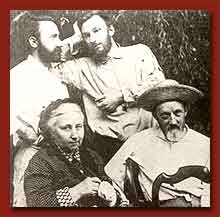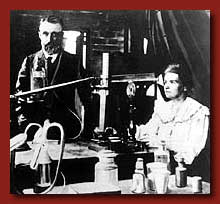 |
|
Pierre Curie (upper right) with his brother
Jacques and their parents. He called his family “exquisite”
when he first talked about them with Marie Sklodowska. |
|

 E
HAD THE HAPPIEST OF CHILDHOODS,
but the unorthodox nature of his education meant that Pierre Curie
was never quite accepted by the French scientific establishment.
His father, a physician, believed that his son's intellect and
personality could be best nurtured through private tutoring. E
HAD THE HAPPIEST OF CHILDHOODS,
but the unorthodox nature of his education meant that Pierre Curie
was never quite accepted by the French scientific establishment.
His father, a physician, believed that his son's intellect and
personality could be best nurtured through private tutoring.
By the age of 14 Pierre had demonstrated a passion and a gift
for mathematics. At 16 he began university studies and at 18 he
was awarded the equivalent of an American master's degree. But
lack of money forced him to put off work toward his doctorate
indefinitely. Instead he became a poorly paid laboratory instructor.
|
“It
is easy to overlook those who have not the active support
of influential persons.”--Marie Curie
|
His first important
scientific collaboration was with his older brother, Jacques. By
the time Pierre was 21 and Jacques 24, the brothers had discovered
the piezoelectric effect (from the Greek word meaning “to press”).
The Curie brothers had found that when pressure is applied to certain
crystals, they generate electrical voltage. Reciprocally, when placed
in an electric field these same crystals become compressed. Recognizing
the connection between the two phenomena helped Pierre to develop
pioneering ideas about the fundamental role of symmetry in the laws
of physics.
The brothers meanwhile
put their discovery to immediate practical use by devising the piezoelectric
quartz electrometer, which can measure faint electric currents.
Nearly two decades later, the device helped Marie Curie in her early
research. In the century following its discovery by the Curie brothers,
the piezoelectric effect was put to use in such familiar everyday
devices as microphones, quartz watches, and electronic components.
 IERRE
WAS ALSO A PIONEER in the study of magnetism. He discovered
a basic relationship between magnetic properties and temperature.
The temperature at which certain magnetic materials undergo a
marked change in their magnetic properties is today called the
Curie point after Pierre. He also invented a highly sensitive
scientific balance, similarly named in his honor, and likewise
extremely useful in Marie's later work. IERRE
WAS ALSO A PIONEER in the study of magnetism. He discovered
a basic relationship between magnetic properties and temperature.
The temperature at which certain magnetic materials undergo a
marked change in their magnetic properties is today called the
Curie point after Pierre. He also invented a highly sensitive
scientific balance, similarly named in his honor, and likewise
extremely useful in Marie's later work.
“[In
science] we can aspire to accomplish something...every discovery,
however small, is a permanent gain.”
-- Pierre Curie to Marie, 1894, urging her
to join him in “our scientific dream.”
|
|
|
Only at the urging
of Marie Sklodowska, whom he met in the spring of 1894, did Pierre
take the trouble of writing up his research on magnetism as a
doctoral thesis. A few months before their marriage he was awarded
a doctorate of science. When Marie's own thesis research led her
to believe that she was on the verge of discovering a new element,
he joined her in the search. After their discovery of polonium
and radium, the Curies decided on a division of labor: he concentrated
on investigating the properties of radium, while she did chemical
experiments with a view to preparing pure compounds.
So it was Pierre
(with a student) who noticed that a speck of radium spontaneously
and perpetually emits heat--discovering what is now called nuclear
energy. He was also, with collaborators, the first to report the
decay of radioactive materials
and the skin burns that radioactive substances can inflict.
|
 |
| Reflecting on her first meeting with Pierre
Curie, Marie Curie recalled being “struck by the open expression
of his face and by the slight suggestion of detachment in his
whole attitude.” |
|
 |
| The Curies in their laboratory at the School
for Industrial Physics and Chemistry. (Photo ACJC) |
|
 APPIEST
WHEN WORKING in the laboratory, Pierre despised the politics
and flattery that were needed to advance in the tight little world
of Paris professors. Still it hurt when he was denied positions
he deserved, for example in 1902 when he tried and failed to enter
the French Academy of Sciences and in 1903 when he was rejected
for a professorship of mineralogy. APPIEST
WHEN WORKING in the laboratory, Pierre despised the politics
and flattery that were needed to advance in the tight little world
of Paris professors. Still it hurt when he was denied positions
he deserved, for example in 1902 when he tried and failed to enter
the French Academy of Sciences and in 1903 when he was rejected
for a professorship of mineralogy.
“My
husband and I were so closely united by our affection and our
common work that we passed nearly all of our time together.”--Marie
Curie
|
|
Marie Curie never
forgave France for what she considered its rude treatment of her
husband--the failure to give him either the honors or the laboratory
facilities he merited. After his untimely death in a traffic accident
in 1906, she devoted the rest of her life to erecting a laboratory
in Paris that would be worthy of Pierre's memory. In a short,
eloquent biography of him, she helped perpetuate an image of the
struggling scientist that encouraged the public to give researchers
the support she had wanted for Pierre.
� 2000 -
American Institute of Physics
|
|

